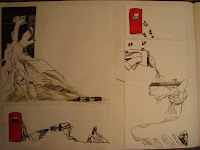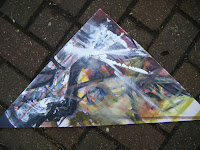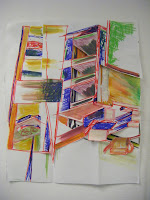I am very ambitious. Yet from what side of the creative field do I see the world? Currently I have choice, I can do anything I want to and this aspect of freedom is something I find exciting. Deciding to narrow my pathway and specialise is something I find daunting and difficult. My struggle in clarity to choose one area over another is due to enjoying 3 of the 4 rotations and furthermore, in my opinion producing successful projects in visual communication, 3d spatial and fashion and textiles. Therefore in the coming assesment dispite the area talks I am still torn in what to choose.
Upon entering the course I was unsure of what degree I was going to choose, even if I was going to do something art based or not. Yet I know now I want to do an art based degree- the excitement and opportunities which each area offers is never the less overwhelming.
At A-level I was always told to stick to one idea, and not to play with too many at one time and this I found limiting as I am constantly coming up with new ideas amidst the bombardment of visual imagery, adverts, and social interaction within the world today. Hence visual communication was almost like therapy, just churning out ideas.
My most successful area I feel was visual communication- it gave me the opportunity to generate lots of ideas and experiment which I loved and contrary to my expectations it was not all computer based and was fast paced, which I liked. I was also introduced to photo manipulation and generating lots of images which I had never done before and I found inspired new ideas. Producing lots of sketchbooks also proved successful and enjoyable.
Within this area I felt the most creative. The brief was clear, I had a target and this more distinct direction compared to the other areas I found helpful. However despite this I am not confident using computers and even though I have been assured this is not a necessity for this area, I feel computer technology is the future, a vehicle and an essential tool to progress to the sort of success I crave. Tutors and students have suggested me to be an illustrator, yet although as is clear from my work I love to draw, I do not want to continue into a freelance environment, feeling around for money and direction. I feel I would be more successful in the competitive environment of advertising as, as others have commented on, my presentation skills.
Another area which I have been considering is fashion and textiles- I enjoyed this rotation and its broadness, using lots of different media- yet I do not know where I would fit into this hugely competitive field. Ever since I was young I have always wanted to work within a fashion magazine, due to my interest in fashion through clothes and magazines. I see my role within this industry as advertisement, management and directing yet I do not know whether this ambition would suit the fashion and textile area. Upon entering the course I would have chosen this area, yet after the crit, compared to visual communication I question how successful I would be within this area.
My least favourite area was fine art- this was a drag, not only due to the vagueness of the project but the length and lack of direction, I need a clear brief to work with and I found this rotation although liberating, with a fat paint brush and large piece of paper, the work I produced in my opinion was unsuccessful, both aesthetically and in motivating me. I also found this area the most challenging in generating ideas and perhaps this reflects in my work.
My least favourite area was fine art- this was a drag, not only due to the vagueness of the project but the length and lack of direction, I need a clear brief to work with and I found this rotation although liberating, with a fat paint brush and large piece of paper, the work I produced in my opinion was unsuccessful, both aesthetically and in motivating me. I also found this area the most challenging in generating ideas and perhaps this reflects in my work.
From crits I have been told I am definitely a fine artist from my drawing, definitely an illustrator for the same reason, a jewellery designer for my use of colour and fondness of smaller scale within 3D, yet I have found this all confusing, I don’t fit into a clear mould. Therefore I hope the assessment with an outsider’s point of view will help concrete a decision between fashion and textiles and visual communication.























